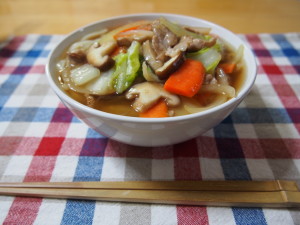Gomoku Ankake Udon
If you’re like me, you probably overindulged a bit over the holiday season and are trying to be healthier. With the cold weather though, this is easier said than done, and I inevitably find myself stuck under my kotatsu eating copious amounts of chocolate.
The good news is that February is the last month of winter; the bad news is it’s also the coldest month in Japan. While hearty winter dishes in the West are often quite rich, Japanese dishes tend be lighter – think nabe- but I think they are just as warming and delicious.
This month’s recipe is a popular winter dish in Japan – hearty udon noodles in a light soup topped with lots of veggies. It’s super simple to make so you’ll be back under your kotatsu in no time. Enjoy!
Serves 1
Prep time: 5-10 minutes
Cooking time: 10 minutes
INGREDIENTS
½ tsp. salt
½ tsp. sesame oil
2-3 thin slices of ginger, peeled and finely diced
50g thinly sliced pork
¼ of an onion
3cm piece of carrot
2 shiitake mushrooms
2 napa cabbage leaves (from a ¼ of a napacabbage)
50 ml water
1 tsp. katakuriko (potato starch) mixed with 1 Tbsp. water
1 packet frozen udon noodles
Soup base
Â
200 ml water
½ tsp. dashi powder
1 tsp. soy sauce
1 tsp. sake (cooking rice wine)
1 tsp. mirin (sweet rice wine for cooking)
METHOD
- Rinse and cut the napa cabbage into 3×3 cm pieces. Cut the onion into thin slices (around ½ cm). Rinse the shiitake mushrooms, trim the stems and cut into thin slices. Peel and cut the carrot in half lengthwise, then cut lengthwise into thin slices. Cut the pork into bite-sized pieces.
- Mix all the ingredients for the soup base in a small pot and cook over medium heat. When it starts to boil, add the frozen udon and cook until the soup starts to bubble.
- In the meantime heat the sesame oil and ginger in a frypan. Add the pork and fry on medium heat for around ½ a minute.
- Add the onion, shiitake mushrooms and carrot and fry for a further 2-3 minutes.
- Add the stems of the napa cabbage and the salt. Fry for another ½ a minute or so then add the leaves.
- Add the water and cook until it starts to bubble. Add the katakuriko and water mixture and turn down the heat. Simmer until it starts to thicken.
- Place the udon noodles and soup from step 2 in a large bowl and pour the meat and vegetable mixture over them.
ADDITIONAL NOTES
- To peel ginger, gently scrape off the skin using the back of a knife. Only peel as much as you need to keep the ginger fresher for longer.
- Katakuriko(ç‰‡æ —ç²‰) is potato starch and is often used in Japanese cooking. Always mix it with cold water before adding to dishes. You can use corn starch (aka cornflour in Australia) instead to thicken the topping or even omit it altogether if you prefer. A thicker consistency helps to retain the heat though and is how it’s traditionally made.
- Feel free to experiment – this is a great way to use up leftover vegetables. Just throw it all in (veggies that take longer to cook in first of course).
- Chicken would also work well, or you can substitute the pork with non-meat alternatives such as atsuage.
- If you don’t have sesame oil you can substitute it with other vegetable oils but it adds a bit of extra flavour.
- You can get udon noodles in all kinds of forms: fresh and cooked, fresh and uncooked, dried etc. I like the texture of the frozen ones the best and they are really easy to use. If the noodles you’re using are un-cooked, cook them in a separate pot in water and not the soup. Feel free to substitute the udon noodles with other types of noodles.







